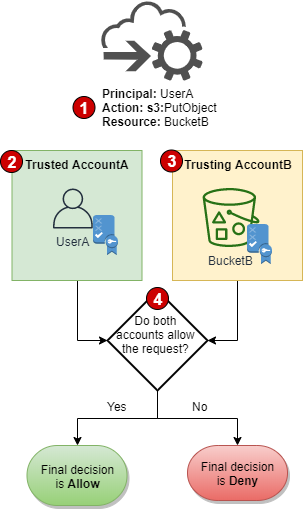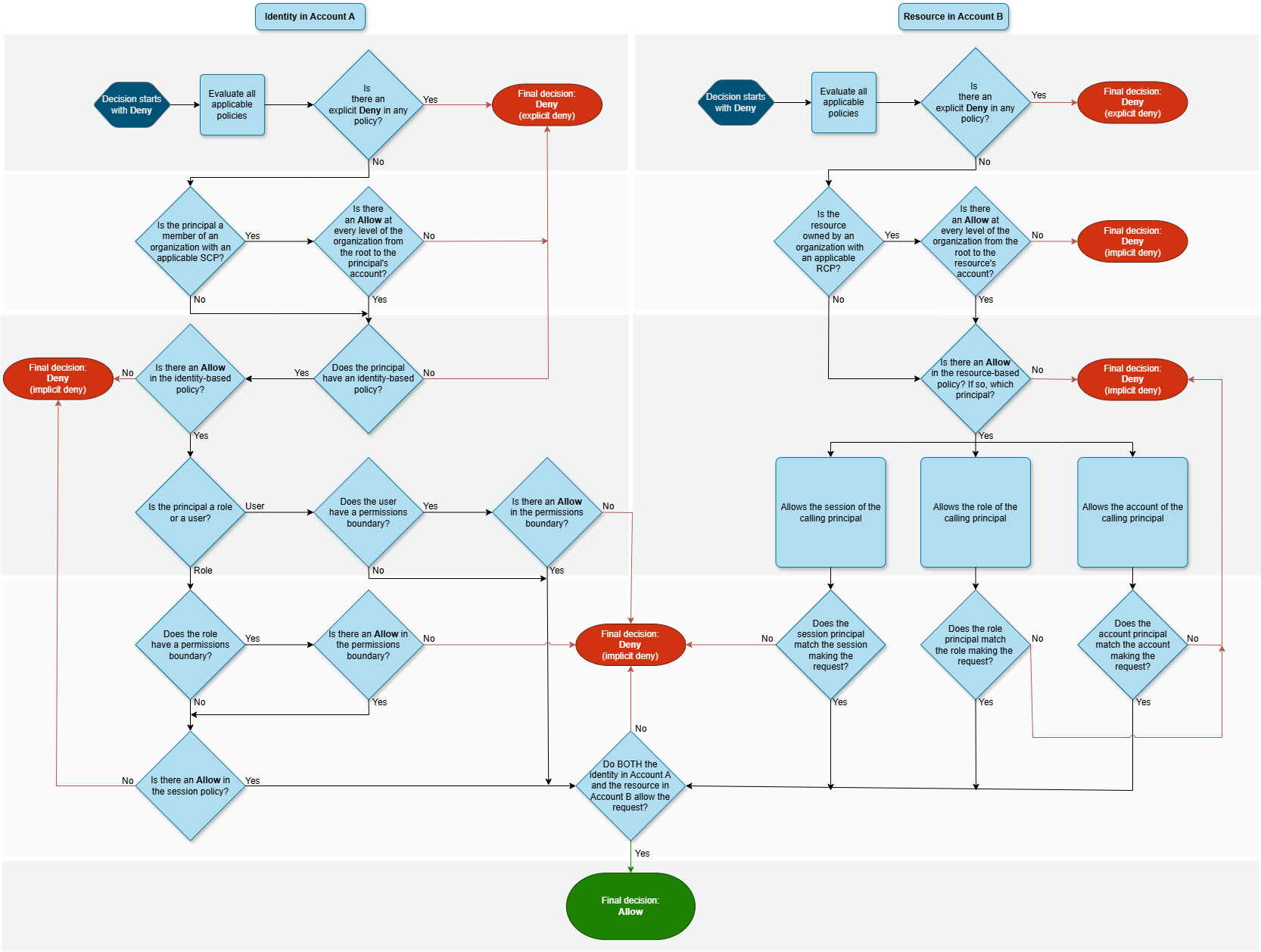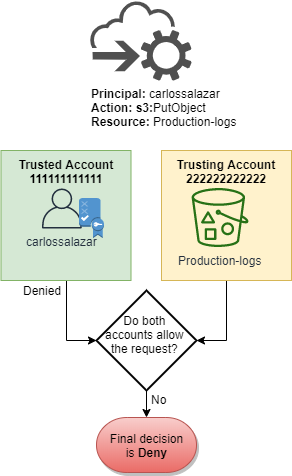Cross-account policy evaluation logic
You can allow a principal in one account to access resources in a second account. This is called cross-account access. When you allow cross-account access, the account where the principal exists is called the trusted account. The account where the resource exists is the trusting account.
To allow cross-account access, you attach a resource-based policy to the resource that you want to share. You must also attach an identity-based policy to the identity that acts as the principal in the request. The resource-based policy in the trusting account must specify the principal of the trusted account that will have access to the resource. You can specify the entire account or its IAM users, Amazon STS federated user principals, IAM roles, or assumed-role sessions. You can also specify an Amazon service as a principal. For more information, see How to specify a principal.
The principal's identity-based policy must allow the requested access to the resource in the trusting service. You can do this by specifying the ARN of the resource.
In IAM, you can attach a resource-based policy to an IAM role to allow principals in other accounts to assume that role. The role's resource-based policy is called a role trust policy. After assuming that role, the allowed principals can use the resulting temporary credentials to access multiple resources in your account. This access is defined in the role's identity-based permissions policy. To learn how allowing cross-account access using roles is different from allowing cross-account access using other resource-based policies, see Cross account resource access in IAM.
Important
Other services can affect the policy evaluation logic. For example, Amazon Organizations supports service control policies and resource control policies that can be applied to principals and resources in one or more accounts. Amazon Resource Access Manager supports policy fragments that control which actions that principals are allowed to perform on resources that are shared with them.
Determining whether a cross-account request is allowed
For cross-account requests, the requester in the trusted AccountA must have
an identity-based policy. That policy must allow them to make a request to the resource in the
trusting AccountB. Additionally, the resource-based policy in
AccountB must allow the requester in AccountA to access the
resource.
When you make a cross-account request, Amazon performs two evaluations. Amazon evaluates the
request in the trusting account and the trusted account. For more information about how a
request is evaluated within a single account, see How Amazon
enforcement code logic evaluates requests to allow or deny access. The request is
allowed only if both evaluations return a decision of Allow.

-
When a principal in one account makes a request to access a resource in another account, this is a cross-account request.
-
The requesting principal exists in the trusted account (
AccountA). When Amazon evaluates this account, it checks the identity-based policy and any policies that can limit an identity-based policy. For more information, see Evaluating identity-based policies with permissions boundaries. -
The requested resource exists in the trusting account (
AccountB). When Amazon evaluates this account, it checks the resource-based policy that is attached to the requested resource and any policies that can limit a resource-based policy. For more information, see Evaluating identity-based policies with resource-based policies. -
Amazon allows the request only if both account policy evaluations allow the request.
The following flow chart provides a more detailed illustration of how a policy evaluation decision is made for a cross-account request. Again, Amazon allows the request only if both account policy evaluations allow the request.

Example cross-account policy evaluation
The following example demonstrates a scenario where a role in one account is granted permissions by a resource-based policy in a second account.
Assume that Carlos is a developer with an IAM role named Demo in account
111111111111. He wants to save a file to the
amzn-s3-demo-bucket-production-logs Amazon S3 bucket in account
222222222222.
Also assume that the following policy is attached to the Demo IAM
role.
The AllowS3ListRead statement in this policy allows Carlos to view a list of
all of the buckets in Amazon S3. The AllowS3ProductionObjectActions statement allows
Carlos full access to objects in the amzn-s3-demo-bucket-production
bucket.
Additionally, the following resource-based policy (called a bucket policy) is attached to
the amzn-s3-demo-bucket-production bucket in account 222222222222.
This policy allows the Demo role to access objects in the
amzn-s3-demo-bucket-production bucket. The role can create and edit, but not
delete the objects in the bucket. The role can't manage the bucket itself.
When Carlos makes his request to save a file to the
amzn-s3-demo-bucket-production-logs bucket, Amazon determines what policies
apply to the request. In this case, the identity-based policy attached to the
Demo role is the only policy that applies in account
111111111111. In account 222222222222, there
is no resource-based policy attached to the amzn-s3-demo-bucket-production-logs
bucket. When Amazon evaluates account 111111111111, it returns a
decision of Deny. This is because the DenyS3Logs statement in the
identity-based policy explicitly denies access to any log buckets. For more information about
how a request is evaluated within a single account, see How Amazon
enforcement code logic evaluates requests to allow or deny access.
Because the request is explicitly denied within one of the accounts, the final decision is to deny the request.

Assume that Carlos then realizes his mistake and tries to save the file to the
Production bucket. Amazon first checks account
111111111111 to determine if the request is allowed. Only the
identity-based policy applies, and it allows the request. Amazon then checks account
222222222222. Only the resource-based policy attached to the
Production bucket applies, and it allows the request. Because both accounts
allow the request, the final decision is to allow the request.
